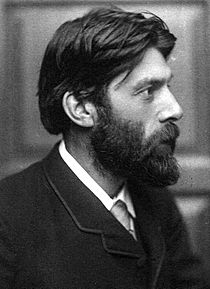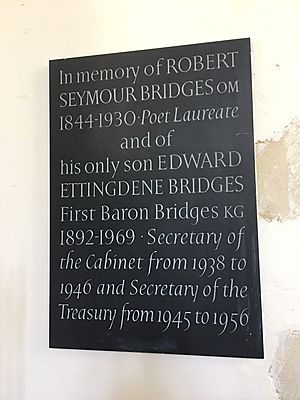Robert Bridges facts for kids
Quick facts for kids
Robert Bridges
|
|
|---|---|
 |
|
| Poet Laureate of the United Kingdom | |
| In office 25 July 1913 – 21 April 1930 |
|
| Monarch | George V |
| Preceded by | Alfred Austin |
| Succeeded by | John Masefield |
| Personal details | |
| Born |
Robert Seymour Bridges
23 October 1844 Walmer, Kent, England |
| Died | 21 April 1930 (aged 85) Boars Hill, Berkshire, England |
| Alma mater | Corpus Christi College, Oxford St Bartholomew's Hospital |
| Occupation | Writer |
| Awards | Poet Laureate |
Robert Seymour Bridges (born October 23, 1844 – died April 21, 1930) was an English poet. He held the special title of Poet Laureate for Britain from 1913 to 1930.
Before becoming a famous writer, he trained as a doctor. Bridges became well-known for his writing later in his life. Many of his poems show his strong Christian beliefs, and he wrote many popular hymns. He also helped his friend, the poet Gerard Manley Hopkins, become famous after Hopkins had passed away.
Contents
Robert Bridges' Life and Career
"The Evening Darkens Over"
The evening darkens over
After a day so bright,
The windcapt waves discover
That wild will be the night.
There's sound of distant thunder.
The latest sea-birds hover
Along the cliff's sheer height;
As in the memory wander
Last flutterings of delight,
White wings lost on the white.
There's not a ship in sight;
And as the sun goes under,
Thick clouds conspire to cover
The moon that should rise yonder.
Thou art alone, fond lover.
Robert Bridges was born in Walmer, Kent, England. He was the fourth son and eighth child of John Thomas Bridges and Harriett Elizabeth. After his father died in 1853, his mother remarried in 1854. The family then moved to Rochdale.
Bridges went to school at Eton College and later studied at Corpus Christi College, Oxford. He then went to medical school in London at St Bartholomew's Hospital. His plan was to work as a doctor until he was 40, then retire to focus on writing poetry.
He worked as a doctor in different hospitals, including the Great Northern Hospital and the Hospital for Sick Children. In 1882, Bridges had to retire early because of lung disease. From then on, he spent all his time writing and studying literature. However, he had already started writing much earlier, with his first collection of poems published in 1873.
In 1884, he married Mary Monica Waterhouse. She was the daughter of a famous architect, Alfred Waterhouse. Robert Bridges lived a quiet life in the countryside for the rest of his days. He first lived in Yattendon and then in Boars Hill, Berkshire, near Oxford, where he passed away.
In 1900, he became a Fellow of the Royal College of Physicians of London. In 1913, he was chosen as the Poet Laureate. He was the only medical doctor to ever hold this important position.
Robert Bridges was the father of poet Elizabeth Daryush and Edward Bridges, who became a high-ranking government official.
Robert Bridges' Poetry and Writing
Robert Bridges' poetry was different from most modern English poems of his time. However, his work greatly influenced a small group of writers. His poems are known for being calm, pure, precise, and strong. He had his own ideas about how poetry should sound and be structured. His strong religious faith was a big part of his writing.
In his book Milton's Prosody, Bridges looked closely at how the poet John Milton used blank verse. He developed a theory that Milton's poems were mainly based on the number of syllables, not just the rhythm. Bridges believed that free verse (poetry without a regular rhythm or rhyme) was too limiting. He explained his thoughts in an essay called "Humdrum and Harum-Scarum".
To make his own poems more "free," he created a style called "Neo-Miltonic Syllabics." These poems were collected in New Verse (1925). The rhythm of these poems was based on syllables, not accents. He used this style again in his long philosophical poem The Testament of Beauty (1929). For this work, he received the Order of Merit award in the same year.
However, his most famous poems are found in his earlier books, Shorter Poems (1890, 1894). He also wrote plays in verse, but they were not as successful. He also wrote literary criticism, including a study of the work of John Keats.
"Melancholia"
The sickness of desire, that in dark days
Looks on the imagination of despair,
Forgetteth man, and stinteth God his praise;
Nor but in sleep findeth a cure for care.
Incertainty that once gave scope to dream
Of laughing enterprise and glory untold,
Is now a blackness that no stars redeem,
A wall of terror in a night of cold.
Fool! thou that hast impossibly desired
And now impatiently despairest, see
How nought is changed: Joy's wisdom is attired
Splended for others' eyes if not for thee:
Not love or beauty or youth from earth is fled:
If they delite thee not, 'tis thou art dead.
Bridges' poetry was first printed privately. It took a while for his work to become known outside a small group of fans. His best poems are in his Shorter Poems (1890). A full collection of his Poetical Works was published in six volumes between 1898 and 1905.
Even though he became Poet Laureate in 1913, Bridges was not very famous until just before he died. That's when his poem The Testament of Beauty became very popular. Many British composers of his time, like Hubert Parry, Gustav Holst, and Gerald Finzi, set his poems to music.
During the First World War, Bridges joined a group of writers. They worked for Britain's War Propaganda Bureau, helping to share information about the war.
At Oxford, Bridges became good friends with Gerard Manley Hopkins. Today, Hopkins is seen as a greater poet. But he owes his fame to Bridges, who helped publish his poems after Hopkins' death in 1918.
Bridges also worked on a new way of spelling words to make them easier to read. He got help from a young language expert named David Abercrombie. Bridges also helped start the Society for Pure English.
Writing Hymns
In 1899, Robert Bridges made an important contribution to church music with his Yattendon Hymnal. He created this collection of hymns especially for musical reasons. Even though it didn't make a lot of money, this hymnal helped connect the older hymns of the late 1800s with the newer hymns of the early 1900s.
Bridges wrote many hymns himself and also translated old ones. Many of these were included in Songs of Syon (1904) and the later English Hymnal (1906). Several of Bridges' hymns and translations are still sung today:
- "Thee will I love, my God and King"
- "Happy are they that love God"
- "Rejoice, O land, in God thy might"
- "Ah, Holy Jesus" (from Johann Heermann, 1630)
- "All my hope on God is founded" (from Joachim Neander, around 1680)
- "Jesu, Joy of Man's Desiring" (from Martin Jahn, 1661)
- "O Gladsome Light" (from Phos Hilaron)
- "O Sacred Head, sore wounded" (from Paulus Gerhardt, 1656)
- "O Splendour of God's Glory Bright" (from Ambrose, 4th century)
- "When morning gilds the skies" (stanza 3; from Katholisches Gesangbuch, 1744)
Robert Bridges' Main Works
Here are some of Robert Bridges' most important published works:
Poetry Collections
- The Growth of Love (1876; 1889; 1898), a series of sonnets.
- Prometheus the Firegiver: A Mask in the Greek Manner (1883).
- Eros and Psyche: A Narrative Poem in Twelve Measures (1885; 1894), a story based on an old Latin tale.
- Shorter Poems, Books I–IV (1890).
- Shorter Poems, Books I–V (1894).
- New Poems (1899).
- Demeter: A Mask (1905), a play performed in 1904.
- Ibant Obscuri: An Experiment in the Classical Hexameter (1916).
- October and Other Poems (1920).
- The Tapestry: Poems (1925), written in his special "neo-Miltonic syllabics" style.
- New Verse (1926), which includes poems from The Tapestry.
- The Testament of Beauty (1929).
Verse Drama (Plays in Poetry)
- Nero (1885), a historical tragedy.
- The Feast of Bacchus (1889), partly translated from an old play.
- Achilles in Scyros (1890), a drama with a mixed style.
- Palicio (1890), a romantic drama in five acts.
- The Return of Ulysses (1890), a drama in five acts.
- The Christian Captives (1890), a tragedy in five acts.
- The Humours of the Court (1893), a comedy based on other plays.
- Nero, Part II (1894).
Prose (Non-Poetry Books)
- Milton's Prosody, With a Chapter on Accentual Verse (1893; 1901; 1921), based on earlier essays.
- Keats (1895), a study of the poet John Keats.
- Hymns from the Yattendon Hymnal (1899).
- The Spirit of Man (1916).
- Poems of Gerard Manley Hopkins (1918), which Bridges edited with notes.
- The Necessity of Poetry (1918).
- Collected Essays, Papers, Etc. (1927–36).
Images for kids
See also
 In Spanish: Robert Bridges para niños
In Spanish: Robert Bridges para niños



